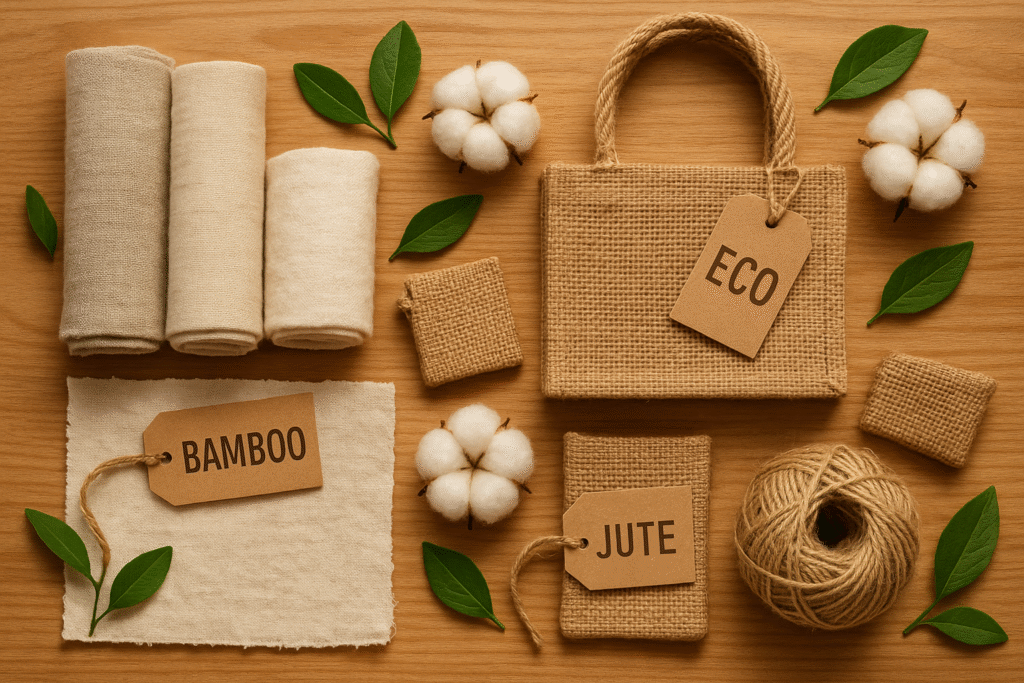The year 2025 marks a turning point for the global textile and fashion industry. For decades, fast fashion dominated our wardrobes with cheap, trendy clothing produced at lightning speed. While this model allowed people to buy more for less, it also left behind a trail of destruction—mountains of textile waste, chemical pollution in rivers, unsafe working conditions for laborers, and a huge carbon footprint.
Now, a new wave of eco-conscious consumers is reshaping the way we think about fashion. Sustainability is no longer just a buzzword; it is a demand and a lifestyle choice. People want clothes, furniture, and textiles that are ethical, eco-friendly, and long-lasting. At the heart of this revolution lies sustainable fabrics—materials that are kind to the planet without compromising on beauty, comfort, or durability.
In this detailed guide, we’ll dive deep into the rise of sustainable fabrics in 2025, why they matter, the most popular eco-friendly textiles, how brands are adapting, and what the future holds for the industry.
🌍 Why Sustainable Fabrics Matter in 2025
The fashion industry is one of the most polluting industries in the world. According to the United Nations Environment Programme (UNEP):
- The fashion industry contributes 10% of global carbon emissions.
- Producing a single cotton T-shirt requires around 2,700 liters of water—enough for one person to drink for 2.5 years.
- Every year, 85% of textiles end up in landfills, creating massive waste problems.
With growing awareness, consumers are now asking tough questions: Where is my clothing made? Who made it? What is it made of?
Key Drivers of Sustainable Fabric Growth:
- Eco-Conscious Consumers – Shoppers are more aware of the environmental impact of their choices.
- Government Regulations – Many countries are introducing rules to reduce waste and promote sustainable practices.
- Brand Responsibility – From luxury houses to streetwear startups, brands are pledging to cut carbon emissions and switch to eco-materials.
- Technology in Textiles – Innovations like recycled fabrics and lab-grown fibers are offering new eco-friendly solutions.
💡 Insight: In 2025, sustainability is no longer optional—it’s an expectation.
🪶 Linen: The Ancient Yet Modern Eco-Friendly Fabric
Linen is one of the oldest known fabrics, dating back thousands of years. Made from the flax plant, it has been a symbol of luxury, durability, and elegance. In 2025, linen is experiencing a resurgence as both designers and consumers rediscover its sustainable qualities.
✅ Why Linen is Sustainable
- Flax grows naturally with minimal need for water or fertilizers.
- Every part of the plant can be used, leaving almost zero waste.
- Linen is biodegradable and recyclable, making it a closed-loop fabric.
✨ Linen in 2025 Fashion & Lifestyle
- Clothing: Linen dresses, oversized shirts, summer suits, and trousers dominate eco-friendly collections.
- Home Décor: Linen curtains, tablecloths, and beddings are trending in sustainable interior design.
- Luxury Brands: Designers are blending linen with silk and organic cotton for high-end collections.
💡 Consumer Tip: Linen softens over time without losing durability—making it a perfect long-term investment.
🌾 Jute: The “Golden Fiber” Reimagined
Jute has long been known as the golden fiber of India and Bangladesh, and in 2025, it’s making a major comeback. Known for its coarse texture and durability, jute was once limited to gunny bags and ropes. But today, designers are transforming it into fashionable, stylish, and sustainable products.
✅ Why Jute is Sustainable
- Grows without pesticides or fertilizers.
- Absorbs large amounts of CO₂, helping reduce greenhouse gases.
- Fully biodegradable and compostable.
✨ Jute in 2025 Fashion & Home Design
- Fashion Accessories: Jute handbags, sandals, and jewelry are trending among eco-fashionistas.
- Home Products: Rugs, carpets, mats, and wall hangings add rustic charm to interiors.
- Packaging: Jute shopping bags are replacing plastic bags in major cities worldwide.
💡 Eco Highlight: Jute blends well with cotton and silk, allowing both durability and elegance in fashion.
🎋 Bamboo: The Fastest Growing Eco-Fabric
Bamboo is one of the fastest-growing plants in the world, capable of growing up to 3 feet in just one day. This makes it a superstar fabric in sustainability. Bamboo textiles are known for their silky feel and luxurious comfort.
✅ Why Bamboo is Sustainable
- Requires little water and no fertilizers.
- Naturally resistant to pests, so no pesticides are needed.
- Biodegradable and eco-friendly.
✨ Bamboo in 2025
- Fashion: Sportswear, activewear, and everyday basics made from bamboo are booming.
- Baby Products: Bamboo baby clothes and blankets are in demand due to their softness.
- Home Products: Towels, bed sheets, and curtains made from bamboo are popular in eco-friendly homes.
💡 Consumer Tip: Look for bamboo linen (mechanically processed) rather than bamboo viscose (chemically processed), which is less eco-friendly.
🌱 Organic Cotton: A Cleaner Future
Cotton has been both a blessing and a curse. While it’s a widely used fabric, conventional cotton farming is highly polluting, consuming massive amounts of water and pesticides. In 2025, organic cotton is leading the charge toward a cleaner, greener textile industry.
✅ Why Organic Cotton is Sustainable
- Grown without synthetic chemicals.
- Often uses rain-fed irrigation instead of wasteful water systems.
- Safer for farmers, soil, and ecosystems.
✨ Organic Cotton in 2025
- Streetwear: Hoodies, t-shirts, and denim jeans dominate organic cotton collections.
- Luxury Fashion: Blended with linen or silk for chic, eco-conscious collections.
- Everyday Products: Reusable tote bags, bedsheets, and towels.
💡 Eco Highlight: Certifications like GOTS (Global Organic Textile Standard) and Fair Trade make it easier for consumers to identify authentic organic cotton.
🌿 Hemp: The Miracle Plant
If there is one plant that has been underestimated for years, it’s hemp. Known for its strength and versatility, hemp is becoming a hero fabric in 2025.
✅ Why Hemp is Sustainable
- Grows quickly with little water.
- Requires no pesticides or synthetic chemicals.
- Improves soil health and prevents erosion.
- Naturally antibacterial and UV resistant.
✨ Hemp in 2025 Fashion & Design
- Clothing: Shirts, pants, and dresses that last longer than cotton.
- Accessories: Hemp backpacks, shoes, and wallets are increasingly popular.
- Home Interiors: Curtains, cushions, and eco-friendly upholstery.
💡 Consumer Tip: Hemp softens with every wash without losing strength, making it an eco-friendly wardrobe essential.
🧵 Other Sustainable Fabrics Emerging in 2025
Beyond the classics, 2025 is also seeing the rise of innovative eco-fabrics:
- Tencel (Lyocell): Made from eucalyptus wood pulp; soft, silky, and biodegradable.
- Recycled Polyester (rPET): Made from plastic bottles; reduces waste but is not biodegradable.
- Piñatex: A fabric made from pineapple leaf fibers, popular in vegan fashion.
- Cork Fabric: Lightweight, waterproof, and durable, used in handbags and shoes.
- Soy Silk: Made from soybean byproducts; soft and shiny like real silk.
👗 How Brands Are Embracing Sustainable Fabrics
2025 is a landmark year where sustainability and fashion meet creativity.
- Luxury Brands: Gucci, Prada, and Stella McCartney are investing in hemp, linen, and recycled fabrics.
- High-Street Brands: H&M, Zara, and Uniqlo are expanding organic cotton and recycled collections.
- Startups: Eco-fashion startups are experimenting with Piñatex, Tencel, and bamboo-based products.
💡 Many brands now release eco-label collections with full transparency about sourcing and fabric sustainability.
🌟 Consumer Guide: How to Build a Sustainable Wardrobe
Adopting sustainable fabrics is not just about buying new clothes; it’s about changing habits.
- Buy Less, Choose Better – Quality over quantity.
- Look for Certifications – GOTS, OEKO-TEX, Fair Trade labels ensure authenticity.
- Mix Sustainable Fabrics – Linen shirts with hemp trousers or organic cotton denim.
- Support Local Artisans – Handloom fabrics reduce environmental impact.
- Care Smartly – Wash cold, air dry, avoid chemical detergents.
🔮 Future of Sustainable Fabrics Beyond 2025
The future of textiles is innovative and exciting. We’re entering an era where fabrics will not only be sustainable but also smart and tech-integrated.
- AI-driven design: Minimizing waste through digital pattern-making.
- Lab-grown fabrics: Bio-fabricated silk and leather.
- Circular Fashion Models: Recycling old clothes into brand-new fabrics.
- Smart Eco-Fabrics: Materials that change with temperature or self-clean naturally.
📌 Final Thoughts
From the timeless charm of linen and the rustic beauty of jute to the modern luxury of bamboo and the strength of hemp, sustainable fabrics are redefining style in 2025.
This shift is not just about fashion; it’s about making responsible choices that protect our planet. Whether you are a designer, a consumer, or a business owner, adopting sustainable fabrics is no longer optional—it’s the way forward.
By choosing fabrics that respect the earth, you are not just dressing for today—you are shaping the future of fashion and living responsibly for generations to come.


